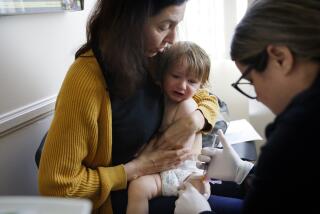MAKING A DIFFERENCE : One partnership’s approach: Vaccinate the Youngest Children
- Share via
Due largely to California’s no-shots-no-school law, more than 90% of children in Los Angeles county are properly immunized when they enroll in kindergarten. But only 42% of children countywide have been immunized by the age of 2, when youngsters are supposed to have received most of their vaccinations. Poor immunization rates among preschool children leave all California residents vulnerable to epidemics like the 1988-91 measles outbreak that killed 51 people statewide. Immunization experts say improved delivery systems, not just free vaccinations, are essential to improve vaccination rates.
One promising form of delivery is a program established by the Hard Rock Cafe and Centinela Hospital in Inglewood. Their mobile vaccination van travels to low-income neighborhoods throughout Los Angeles County delivering immunizations to infants and children. No verification of income or citizenship or other documents are requested or required. The van visits 23 sites regularly throughout the county to innoculate youngsters with vaccines and booster shots provided at no cost from county health services agency. Nearly 7,000 children have received vaccinations since the van hit the streets one year ago.
20% of African American children
34% of Latino children
37% of Asian children
50% of Anglo children
Source: Centinela Hospital, Centers for Disease Control
IMMUNIZATION BARRIERS
Low immunization rates seldom reflect ignorance or neglect by parents, according to public health experts. Many parents, for example, may know about free vaccinations but fear they will be asked for verification of income, citizenship or other documents. In addition, few county clinics that provide immunizations offer services on Saturdays. All of the clinics limit immunizations to certain days and hours, and many clinics maintain quotas on the number of immunizations they can provide at one time. The situation is complicated by the fact that children by age 2 should receive a total of more than a dozen vaccinations during five visits to health-care providers.
Charles H. Alexander, immunization program director, Los Angeles County Health Services. He elaborated on other barriers:
NO COMMON ACCESS FOR INFANTS:
“Most parents and families understand that immunization is required for school or licensed day-care, so many wait to immunize. We need to find some way that’s as effective as school immunization policy to catch kids early in life. We need to find common experiences among this very young population and reach them.”
POOR FOLLOW-THROUGH:
“We find that new mothers are very concerned initially and start the immunization sequence on time, but between two months and two years personal factors (like transiency, inflexible work schedules and transportation limits) interrupt the five visits essential for full immunization. We try to educate, inform and motivate parents to follow through, but we’ve not been that successful overall.”
PRIVACY AND CIVIL RIGHTS:
“There are human rights and liability issues in the United States that don’t exist in many other countries. In other countries, it’s often no problem to simply round up every child in a village and innoculate them. In our country there are different rights to privacy and a lot of paperwork to deal with.”
LIMITED RESOURCES:
“We don’t have the international (financial) support that many countries have. Our health concerns are fragmented and directed at many different priorities. We know a computer tracking system would be effective in monitoring the immunization of children, but we are facing extreme budget pressures. If I were in a small town, I’d spend $5,000 on a computer, but here in Los Angeles County it will be a massive job spending time, personnel and equipment to establish a tracking system and appropriate delivery systems.”
More to Read
Sign up for Essential California
The most important California stories and recommendations in your inbox every morning.
You may occasionally receive promotional content from the Los Angeles Times.













![Vista, California-Apri 2, 2025-Hours after undergoing dental surgery a 9-year-old girl was found unresponsive in her home, officials are investigating what caused her death. On March 18, Silvanna Moreno was placed under anesthesia for a dental surgery at Dreamtime Dentistry, a dental facility that "strive[s] to be the premier office for sedation dentistry in Vitsa, CA. (Google Maps)](https://ca-times.brightspotcdn.com/dims4/default/07a58b2/2147483647/strip/true/crop/2016x1344+29+0/resize/840x560!/quality/75/?url=https%3A%2F%2Fcalifornia-times-brightspot.s3.amazonaws.com%2F78%2Ffd%2F9bbf9b62489fa209f9c67df2e472%2Fla-me-dreamtime-dentist-01.jpg)